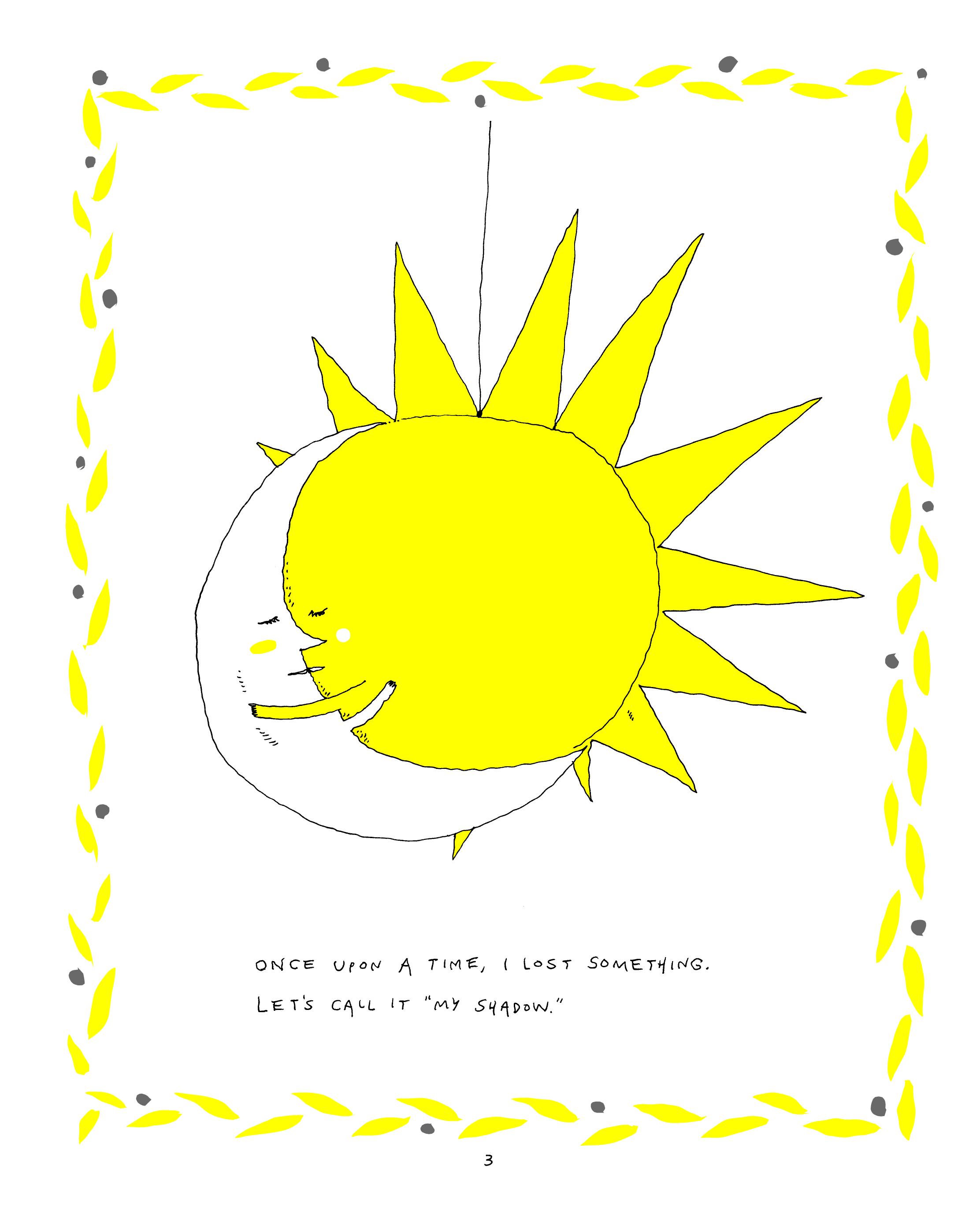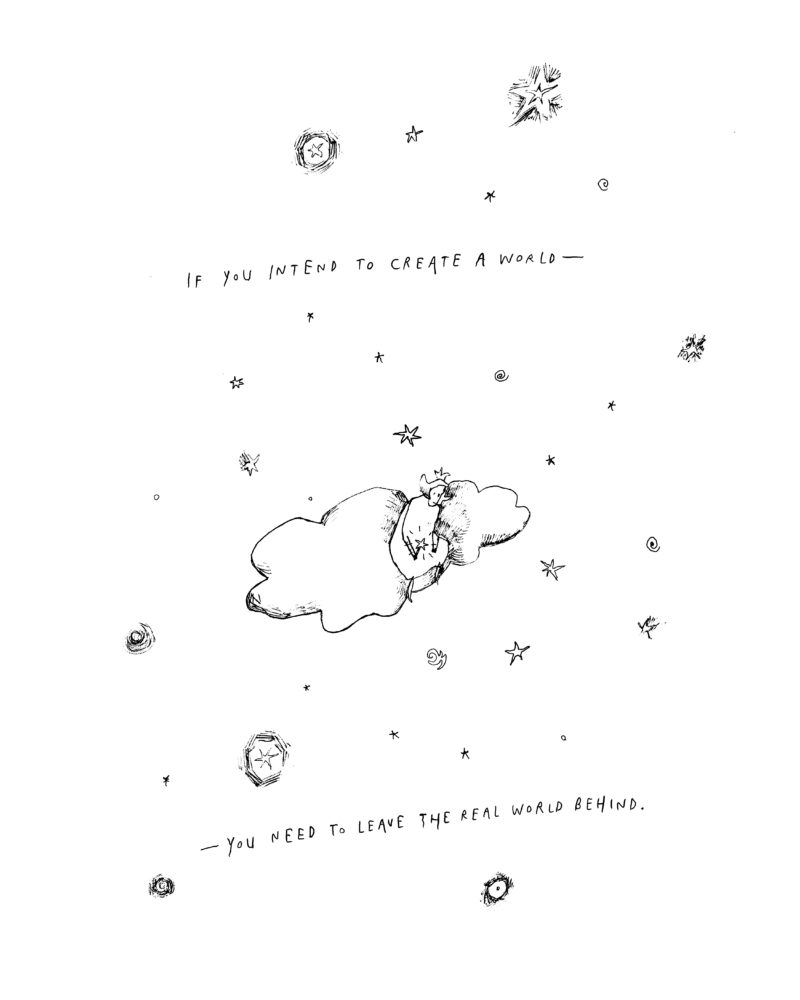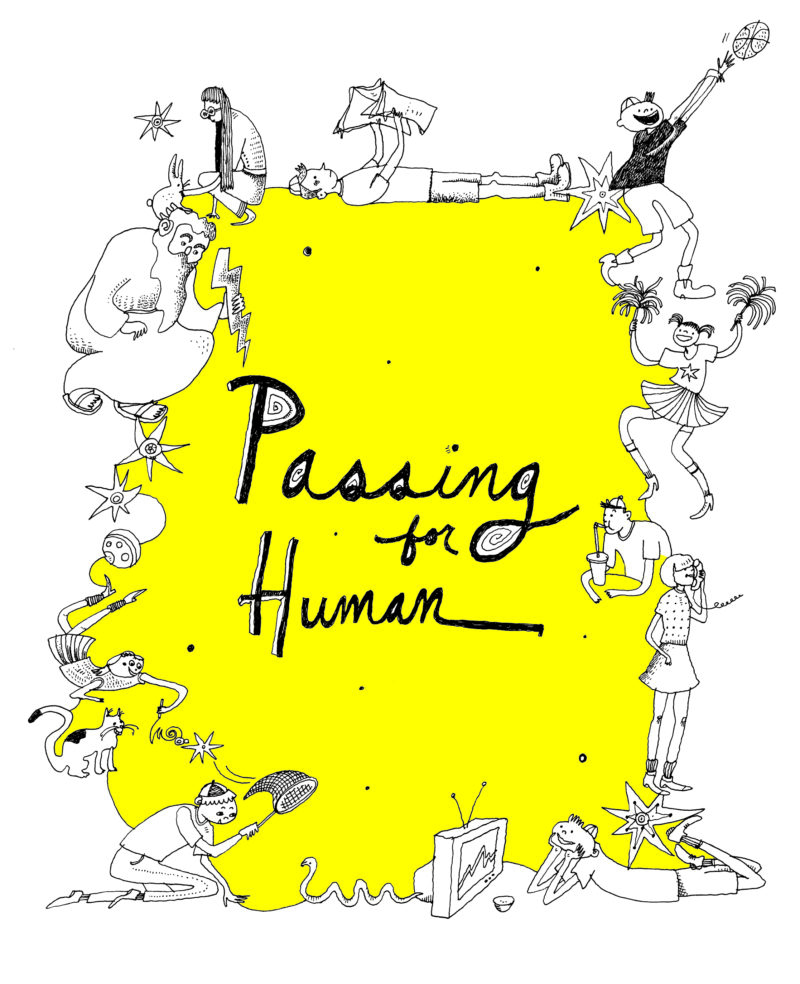
“I think my real talent is for being quick and impatient. I’m not someone who should be spending all her day doing something slow and painstaking.”
Situations on which Liana Finck’s Cartoons Have Commented:
The Fine Line Between Being Responsible and Overbearing
Hearing a Ghost Click a Pen
The Terror of Being
Liana Finck has a knack for noticing, and interpreting, human behaviors. Her quick-witted, quirky sense of distillation and humor is frequently on display, whether in her The New Yorker cartoons, on her Instagram (188k followers and counting), or in her longer published works. Passing for Human is her second book-length work of comics, and in it she turns her observational skills on herself. A graphic memoir, the story it tells is as much about the complicated process of piecing together a life as it is a narrative conveying the details of that life. In fact, the book is mainly composed of beginnings. Each central chapter tackles the protagonist, Leola’s, autobiography from a different vantage point, as she searches for her shadow, lost to her somewhere in the throes of adolescence.
Drawn in a serious, simple style reminiscent of Saul Steinberg, or some of Edward Gorey’s sketchier illustrations, the book’s recursive structure provokes more questions than it answers. When do our stories begin? To whom, or to what, do we owe our senses of selves as distinct from those around us? What, indeed, makes us human?
I sat down with Liana on a late summer day, over a bowl of fresh blueberries and two strong cups of coffee. We discussed her latest project, including her process, the motivations behind her book, and her favorite places to work.
— Tahneer Oksman
THE BELIEVER: What were the roots of Passing for Human?
LIANA FINCK: It started out a long time ago. I was very slowly finishing my other book, A Bintel Brief. In the gaps, while it was slowly grinding to a halt, I needed a new project. I really hate not knowing what I’m doing, so I chose to just give myself an assignment. The project was to adapt Nabokov’s The Real Life of Sebastian Knight. I was doing it pretty straight up. I was doing it badly. I was young, and I didn’t know I’m not someone who should be adapting novels.
And then my agent at the time asked the Nabokov Estate if I had permission to do it, and they said no. So, I started changing things around. I changed the two brothers to two sisters. And then I changed one of the sisters to a shadow. I’m very tenacious so I didn’t give up on the whole project—I just changed it. I changed it to a story of a shadow who has run away from its person, and it comes back. It’s this madcap comic strip of the person trying to get the shadow to see her, but the shadow doesn’t see her. I failed at that too, but by then I had enough material that I could go back and pick at it. In picking at it, the book became a memoir.
BLVR: You open with a “note,” explaining that you have changed names and that the characters are all “seen through my eyes.” Why did you feel that was necessary?
LF: I did change all the names, not for legal reasons, but to be kind. I originally had all of our names real, and I think my parents felt a little bit exposed. I’m not sure; I just had that feeling. I think that using someone’s name but changing the facts about them is the ultimate privacy. But I think other people feel that telling the real facts with fake names is more private for some reason. These facts aren’t all totally real but most of them are pretty close. It was hard to write because of that. I’m not someone who really likes to record facts.
BLVR: How would you describe the process of putting the book together?
LF: This was a project of editing more than writing. All of the “Chapter Ones” were supposed to be Chapter One of a whole book. I was self-conscious about making a comic book. When I started, I hadn’t developed my technique enough to be comfortable. I kept stopping because I would get lost.
Eventually, I jammed all of the Chapter Ones together and very, very slowly redid everything a million times, taking little parts out until it made sense. It’s a slow and thoughtful way of working, and I don’t think it’s how I’ll work in the future.
BLVR: In Leola’s childhood, there seems to be a split between her home life, which is often magical, and her school life, which is often terrible. Why do you think there was such a stark contrast between the two?
LF: I think I felt more of a divide than most people do, but I also think most people I know now are also people who felt a divide, when they were younger, between who they really were and who they were at school.
 For me, home represented art and nature and love. When my mom married my dad, she quit her architecture job and poured all of her creative energy into making this magical childhood for us. She designed this very beautiful house in the country for our family. She spent so much time with me and would make things with me because that was where her creativity went. I remember her making me this tiny model of our house out of paper. Also, we lived in the country—there was a mountain behind the house, there was our dog, Pepper, there were all these animals in the woods, there were gardens, there was a vine on the mountain that you could swing on, there were bears. It was a whole world. I wasn’t very socially adept so it was nice for me to be around the animals and the rocks and the house and not have to talk to other kids.
For me, home represented art and nature and love. When my mom married my dad, she quit her architecture job and poured all of her creative energy into making this magical childhood for us. She designed this very beautiful house in the country for our family. She spent so much time with me and would make things with me because that was where her creativity went. I remember her making me this tiny model of our house out of paper. Also, we lived in the country—there was a mountain behind the house, there was our dog, Pepper, there were all these animals in the woods, there were gardens, there was a vine on the mountain that you could swing on, there were bears. It was a whole world. I wasn’t very socially adept so it was nice for me to be around the animals and the rocks and the house and not have to talk to other kids.
When I went to school, it was really awkward. I don’t think anyone ever saw me. And that was a weird divide, but at the same time I had such a strong sense of self because I knew I was good at drawing, I loved to draw. I knew I loved nature. There was just so much otherwise that school didn’t feel real.
Over the course of the book, school begins to feel more real and I start to lose the things that really make me myself. I make a bargain with the devil that I’ll throw away all the things I care about in order to fit in with the other kids.
BLVR: At one point your protagonist calls the book “a neurological coming-of-age story.” Would you say more about what that means?
LF: One of the “Chapter Ones,” the one about my dad, is looking at me through the lens of my dad through the lens of being neurologically different. I’ve wondered at times in my life whether I have or had some form of mild autism or [what used to be known as] Asperger’s. It’s a compelling story, to think there’s a reason I didn’t have friends at school and it’s because I’m part of this small tribe of people and there are other people like me and I’m not all alone. In fact, this thing that made me not able to have friends also made me good at drawing because often people with mild autism are very focused and very good at one thing.
So to me it was a beautiful origin story. I think I needed it at times in my life, and I don’t need it anymore. I don’t think my dad ever needed it, and I don’t think he relates to it at all. I feel a little weird that I pinned this story on him. I also think calling yourself neurologically different if there’s no very big need to is dangerous because people will see you differently and treat you differently, unfortunately. I don’t think they should, but that’s the world we live in. I never got diagnosed, and I don’t want to now.
BLVR: Were there particular books or ideas that helped you shape this as a “coming-of-age neurological story,” or that helped you better understand your sense of difference?
LF: When I was researching autism I read books by Daniel Tammet, including Born on a Blue Day; and I read all of the things Temple Grandin wrote; and I read Far From the Tree by Andrew Solomon; and I read Neurotribes by Steve Silberman. There were others. I don’t think I even had words to say I was alienated at school until I started researching Asperger’s.
Also, I connected to feminism. Just learning how concrete things shape your experience is really interesting. It gives truth to your experience.
 BLVR: Could you say more about your interest in feminism, and women’s experiences?
BLVR: Could you say more about your interest in feminism, and women’s experiences?
LF: I would say the book’s overarching theme is that it’s about the conflicts one faces when one is a woman and an artist. I think men have been shaped by society in such a way that if they make art it’s for the world, and there’s no conflict between being creative and being ambitious and being a career-person. But women, especially for women of previous generations, like my mom, were shaped by society to think that whatever they make should be for the love of a man and for their kids. My mom’s an artist to the tips of her fingers, but I think she felt a conflict between putting her art into her career and having a family. She ended up putting her best art into us, and the world didn’t get to see it. It was like this beautiful flower that dies at the end of the year. It didn’t leave her with much.
BLVR: Many images in the book, developed through hatching and cross-hatching, bring the reader’s attention to the labor that went into making each page, or panel. Could you talk a little about that style, apparent, for example, on the cover?
LF: The book was originally called “light and shadow.” It has shadows in it, so I thought, whenever there’s black—which there often is, because there are all these characters who are shadows—I’ll fill it in. In part, all of the hatching and cross-hatching were meant to call to mind a form of “women’s work,” like knitting or basket weaving.
It took me forever. It was especially annoying because the drawings are all very simple but I did them a million times, and I didn’t have the forethought to think not to color in the black every single time. I got some carpal tunnel.
BLVR: I would imagine that making all of those marks also gave you time to let your mind wander.
LF: I have mixed feelings about that. When I worked on this book I think that ninety-nine percent of my work was busy work. I would listen to podcasts and talk on the phone and stuff. But I think my real talent is for being quick and impatient. I’m not someone who should be spending all her day doing something slow and painstaking.
So, I thought, no more busy work; I’m going to find the quickest way from now on. I’m never going to hatch or cross-hatch anymore, or anything like that. And I did start working like that. Suddenly, I think I only needed to work like three hours a day. And then I got depressed because I like to do something with my day. So now I do a mixture of busy work and thinking work. But I think I was doing too much busy work and not enough thinking work before.
BLVR: Can you talk me through that distinction? How does this kind of book-composition compare with creating your Instagram or The New Yorker cartoons? How did you balance all of these projects?
LF: I think The New Yorker and Instagram are both very much thinking work and not busy work. The Instagram most of all; I just do one take and it’s very small and I photograph it. There’s probably two minutes between having the thought and having it out in the world.
With The New Yorker cartoons, I spend a day thinking each week, and that’s the real joy of the work. And then I spend another two days drawing them, maybe one day.
The Instagrams are also more autobiographical. When I’m doing The New Yorker work, I have to leave myself and be in a very calm state of mind and not be thinking about my own life. I think of making The New Yorker cartoons as doing scales. It’s a strong format, like a sonnet, and I’m working within it. I couldn’t do it all the time but to have it as this lovely anchor that I do every week is very nice.
Those are the two things I do no matter what. I always wonder why I need a book project. I don’t think it’s my real talent; it doesn’t come naturally to me to tell a long narrative. But I think I need something to be immersed in all the time. You can’t be immersed in cartoons like that; they’re like butterflies.
BLVR: On your Instagram cartoons, you picture your alter ego working in different spaces. Where do you enjoy working, or what spaces are most productive?
LF: Whenever I change projects, I drastically change my work environment. There are some times in my life when I can’t be at home at all, and I’m just a café nomad. It’s stressful because if you switch cafés it’s hard to find a seat and people are rude. I’m very claustrophobic about being near strangers’ bodies; it freaks me out. I always think someone will attack me if they’re too near.
Generally, if I don’t know what I’m doing, I don’t like to be home. Being alone is overwhelming, especially being around this place I’m responsible for. It’s a big weight on me. I’ll look around and see something imperfect in my house, and just feel like a terrible person. But in a café you don’t feel responsible in that way.
I also like to work on the subway. I like to work in parks. These are all things that I like to do under very perfect circumstances. But then you’ll go to a park and expect it to be perfect but maybe it will be ninety degrees and it will be horrible and your iPad will die from the heat. And maybe you love working on the subway, but suddenly it’s crowded and you’re standing up and then you’ve wasted an hour. Home is a constant, and I wish I could work at home more. When I’m immersed in a project I like to be home; I work on the couch.
BLVR: What inspires your work? What do you enjoy looking at, or reading, or listening to?
LF: Podcasts are like a drug for me; they’re for coping. I need them all the time.
Novels feed my work. I take in very little art. I used to love poetry because you could just read one poem, and you’ve read a poem. I think that’s how I treat art in general. Lately, every night I read two pages of a comic book and two pages of a novel. My great self-care ritual. I go to the Met once a week. I love nature; I need to see an open space once a week also. I go to the beach. I go for a run. I don’t know if I could live far from a park or a river. I live near the park right now; I go every day. I see a person every day. It takes me out of myself.
BLVR: Do you think you’ll continue to focus on memoir, or is there memoir fatigue that eventually kicks in?
LF: I think I’ll always be working off something, whether that’s life or maybe old folktales or something I know and care about. I don’t think I’ll be making up stories unless they’re thinly veiled.
What I’m good at is commenting. And I don’t think it’s that easy to comment using fiction. It’s not like I want to tell the facts of what happened to me. I want to explain to myself why the things happened.




